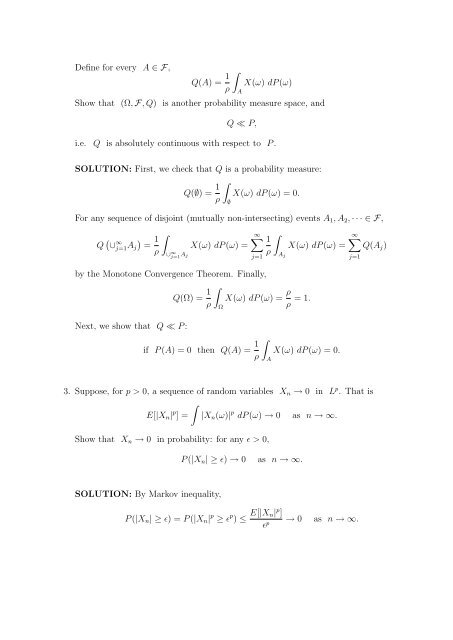Math 664 Homework #2: Solutions 1. Let Ω = R, F = {A â R : either A ...
Math 664 Homework #2: Solutions 1. Let Ω = R, F = {A â R : either A ...
Math 664 Homework #2: Solutions 1. Let Ω = R, F = {A â R : either A ...
Create successful ePaper yourself
Turn your PDF publications into a flip-book with our unique Google optimized e-Paper software.
Define for every A ∈ F,Q(A) = 1 ∫ρAX(ω) dP (ω)Show that (Ω, F, Q) is another probability measure space, andQ ≪ P,i.e. Q is absolutely continuous with respect to P .SOLUTION: First, we check that Q is a probability measure:Q(∅) = 1 ∫X(ω) dP (ω) = 0.ρ∅For any sequence of disjoint (mutually non-intersecting) events A 1 , A 2 , · · · ∈ F,Q ( ∫)∪ ∞ 1j=1A j = X(ω) dP (ω) =ρ ∪ ∞ j=1 A j∞∑j=1∫1X(ω) dP (ω) =ρ A jby the Monotone Convergence Theorem. Finally,Q(Ω) = 1 ∫X(ω) dP (ω) = ρ ρρ = <strong>1.</strong>Next, we show that Q ≪ P :if P (A) = 0 then Q(A) = 1 ρΩ∫AX(ω) dP (ω) = 0.∞∑Q(A j )j=13. Suppose, for p > 0, a sequence of random variables X n → 0 in L p . That is∫E[|X n | p ] = |X n (ω)| p dP (ω) → 0 as n → ∞.Show that X n → 0 in probability: for any ɛ > 0,P (|X n | ≥ ɛ) → 0 as n → ∞.SOLUTION: By Markov inequality,P (|X n | ≥ ɛ) = P (|X n | p ≥ ɛ p ) ≤ E[|X n| p ]ɛ p → 0 as n → ∞.
















